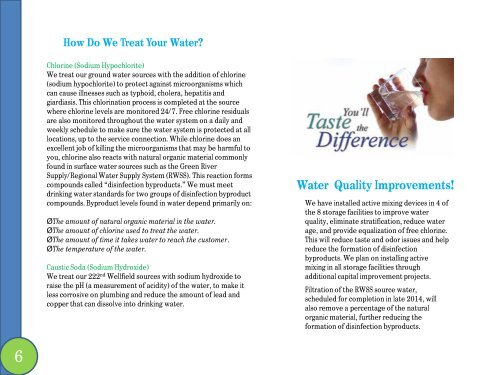2010 Annual Water Quality Report - CWD - Covington Water District
2010 Annual Water Quality Report - CWD - Covington Water District
2010 Annual Water Quality Report - CWD - Covington Water District
- No tags were found...
You also want an ePaper? Increase the reach of your titles
YUMPU automatically turns print PDFs into web optimized ePapers that Google loves.
How Do We Treat Your <strong>Water</strong>?Chlorine (Sodium Hypochlorite)We treat our ground water sources with the addition of chlorine(sodium hypochlorite) to protect against microorganisms whichcan cause illnesses such as typhoid, cholera, hepatitis andgiardiasis. This chlorination process is completed at the sourcewhere chlorine levels are monitored 24/7. Free chlorine residualsare also monitored throughout the water system on a daily andweekly schedule to make sure the water system is protected at alllocations, up to the service connection. While chlorine does anexcellent job of killing the microorganisms that may be harmful toyou, chlorine also reacts with natural organic material commonlyfound in surface water sources such as the Green RiverSupply/Regional <strong>Water</strong> Supply System (RWSS). This reaction formscompounds called “disinfection byproducts.” We must meetdrinking water standards for two groups of disinfection byproductcompounds. Byproduct levels found in water depend primarily on:‣The amount of natural organic material in the water.‣The amount of chlorine used to treat the water.‣The amount of time it takes water to reach the customer.‣The temperature of the water.Caustic Soda (Sodium Hydroxide)We treat our 222 nd Wellfield sources with sodium hydroxide toraise the pH (a measurement of acidity) of the water, to make itless corrosive on plumbing and reduce the amount of lead andcopper that can dissolve into drinking water.<strong>Water</strong> <strong>Quality</strong> Improvements!We have installed active mixing devices in 4 ofthe 8 storage facilities to improve waterquality, eliminate stratification, reduce waterage, and provide equalization of free chlorine.This will reduce taste and odor issues and helpreduce the formation of disinfectionbyproducts. We plan on installing activemixing in all storage facilities throughadditional capital improvement projects.Filtration of the RWSS source water,scheduled for completion in late 2014, willalso remove a percentage of the naturalorganic material, further reducing theformation of disinfection byproducts.6


